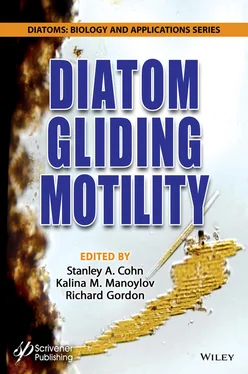8 Chapter 8Figures 8.1–8.13 LM images of Eunotia taxa in valve view (Figures 8.1–8.8) and girdle view, ventral-side up (Figures 8.9–8.11) to show variation in morphology and raphe shape and location (arrow in some images). (Figure 8.1 [8.28]) E. bilunaris (Ehrenb.) Souza – raphe recurved almost 180°. (Figure 8.2) E. serra Ehrenb. – raphe on valve face with slight curve toward apex. (Figure 8.3 [8.28]) E. areniverma Furey, Lowe et Johansen – raphe follows margin of apex from ventral to dorsal margin, and up onto dorsal mantle. (Figure 8.4 [8.28]). E. pectinalis var. ventricosa (Ehrenb.) Grunow ( E. pectinalis var. ventralis (Ehrenb.) Hust. = synonym). (Figure 8.5) E. bigibba Kütz. – raphe with slight recurve. (Figure 8.6) E. incisa Smith ex. Gregory – raphe (not visible) only present on valve mantle (see Figure 8.17). (Figure 8.7) E. muscicola Krasske – raphe (not visible) on the valve face with slight recurve (see Figure 8.20). (Figure 8.8) Close up of valve apex and raphe of E. bilunaris in Figure 8.1. (Figure 8.9) E. bigibba and (Figure 8.10) E. tetraodon Ehrenb. – ventral-girdle view. Depth of valve only permits part of raphe to be in focus (on one plane) at a time. (Figure 8.11) Unknown valve in ventral-girdle view. Raphe almost all in focus. (Figure 8.12) Epiphytic cells of E. bilunaris (E) standing up on end from the mucilaginous sheath(s) of the cyanobacterium Hapalosiphon Nägeli ex Bornet et Flahault (Image credit R.L. Lowe). (Figure 8.13) SEM image of Eunotia on a bryophyte. For all images except for Figure 8.8: black scale bar = 10 μm. Figure 8.8: white scale bar = 5 μm. (Figures 8.1, 8.3, 8.4 originally published in Furey et al . [8.28] www.schweizerbart.de/journals/bibl_diatom).Figures 8.14–8.22 SEM images of Eunotia taxa to show variation in morphology, along with external and internal raphe (R) shape and location on the valve face and valve mantle, helictoglossa (h), shape, location, and internal expression of the rimoportula (r), and external expression of the rimoportula pore (rp). (Figure 8.14 [8.28]) E. areniverma – raphe follows margin of apex from ventral to dorsal margin, and up onto dorsal mantle. (Figure 8.15 [8.28]) E. areniverma – internal view of apex. Rimoportula located mid apex. (Figure 8.16 [8.28]) E. pectinalis var. ventricosa – external view showing path of raphe from mantle onto valve face with slight recurve. (Figure 8.17 [8.28]) E. incisca – raphe located completely on valve mantle. External expression of rimoportula. (Figure 8.18) E. bigibba – curve of raphe onto valve face with slight recurve. (Figure 8.19) E. serra – raphe on valve face with slight curve toward apex. (Figure 8.20) E. muscicola – curve of raphe onto valve face with a slight recurve and (Figure 8.21) internal view of valve apex with rimoportula located close to the helictoglossa. (Figure 8.22) E. serra – internal view of valve apex with rimoportula located closer to dorsal margin. Scale bars as shown. (Figures 8.14–8.17 originally published in Furey et al . [8.28] www.schweizerbart.de/journals/bibl_diatom). [8.38] [8.53] [8.66], though their position could be derived if a more complex raphe system became reduced (discussed by Kociolek [8.44] and Siver and Wolfe [8.69]). Movement in eunotioid diatoms with their short raphe system, typically described as slightly (< 2 µm/sec [8.31]) or weakly motile (2 to 4 µm/sec [8.31]) (see eunotioid taxa in DONA [8.21] – Furey [8.26]), contrasts with that of more motile forms like naviculoid, nitzschioid, or surirelioid diatoms with more extensive raphe systems, typically described as moderately to highly motile. Examination of motility in Eunotia species may provide unique insight into motility in diatoms, especially for diatoms with more complex raphe systems. A search for the terms “motile” or “move” in florae focused on Eunotia (e.g., [8.20] [8.28] [8.48] [8.51]) and in >40 manuscripts with descriptions of Eunotia taxa new to science revealed little to no mention of motility. This chapter focuses on motility in the diatom genus Eunotia , but does not cover cellular or biomechanical details around the mechanisms of movement, as other chapters in this book discuss these aspects at length.Figures 8.23–8.27 Schematic representation of some of the movement types for Eunotia . (Figure 8.23) Schematic of forward movement – apical displacement where cells tilt slightly so the anterior ends of the valves remain in contact with the surface and the posterior ends become slightly raised (**schematic modeled after Palmer [8.60] plate vi. fig. 2, and Bertrand [8.6] fig. 1**). (Figure 8.24) Valve in girdle view. (Each raphe branch labeled after Bertrand [8.6] (**see also Harbich [8.30]**). Black arrow following the line of the raphes on B to C apices represents diagonal line of direction, where the raphe on the C end becomes active. (Figure 8.25) Black horizontal arrow represents diagonal line of direction. Bidirectional arrow shows transition between raphes involved in forward motion (**schematic modeled after Bertrand [8.6], fig. 1**). (Figure 8.26) Schematic of a vertical polar pivot which can return a cell in girdle view, dorsal-side down (a) to ventral-side down (b,c) where a cell can then continue forward movement (c) (**schematic modeled after Palmer [8.60], plate vi. fig. 2, and Bertrand ([8.6], fig. 5]**). (Figure 8.27) Schematic of a horizontal, polar pivot (a,b) to show direction of raphe activity (straight arrows, A and B). Note the cell is depicted ventral side up so the raphe branches are visible (rather than dorsal side up as the movement occurs). Curved arrows show direction of rotation. Dot represents the pivot point. (**Modified after images from Harbich [8.30]). See additional schematics in Bertand [8.5].
9 Chapter 9Figure 9.1 Gliding cells of Nitzschia sigmoidea with stalked epiphytes of Pseudostaurosira parasitica : a single epiphyte in connective view (a), in valve view (b), and two epiphytes attached to the same frustule (c), which can be seen in movement [9.39].Figure 9.2 Cells of Nitzschia sigmoidea with adnate epiphytes of Fallacia helensis (OM): single epiphyte in connective view and host in valve view (a), four epiphytes in valve view and host in connective view (b), which can be seen in movement [9.43].Figure 9.3 Cells of Nitzschia sigmoidea with many epiphytes (OM): epiphytes of Amphora copulata on a still gliding host (a), epiphytes of Amphora copulata on a dividing host (b), epiphytes of Amphora copulata and Pseudostaurosira parasitica on the same host (c), which can be seen in movement [9.41].Figure 9.4 Focus on epiphytes of Nitzschia sigmoidea (SEM). Adnate, Fallacia helensis , and stalked, Pseudostaurosira parasitica , epiphytes on the same host (a), two cells of Pseudostaurosira parasitica still associated after division (b), two superimposed cells of Fallacia helensis after division and a third single one attached on the edge of the frustule (c), apex of a cell of Pseudostaurosira parasitica with the mucilaginous pad secreted for adhesion (d), individual of Amphora copulata (e) and internal view of one valve of Amphora sp., probably Amphora copulata var. epiphytica Round & Kyung Lee, considering the almost circular areolae on the ventral side (f). Scale bars indicate 10 µm, except in 9.4d (=5 µm).Figure 9.5 Variations in the specific composition of epiphytes on Nitzschia sigmoidea between two sampling sites located on two connected rivers (up- and downstream sites), expressed as the occurrence of three epidiatomic species on frustules of N. sigmoidea . In fact, through the observation of fresh material, N. sigmoidea could not be strictly distinguished from the close species N. vermicularis . Both species were present in each site (see [9.44] for details).Figure 9.6 Sigmoid frustules of Nitzschia sigmoidea (NSIO) and Gyrosigma attenuatum (GYAT) (OM, H 2O 2treated material). Two species co-occurring in rivers samples with similar abundance, valve length and motility. However, Gyrosigma attenuatum was never seen with epiphytes.
Читать дальше












